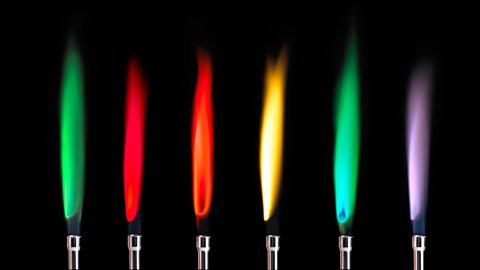Flame Test
A flame test is a qualitative analysis technique used in chemistry to detect the presence of certain metal ions based on the color they emit when heated in a flame. Here’s a step-by-step guide to performing a flame test:
Applications of Flame Test
- Identification of Metal Ions:
- Qualitative Analysis: Flame tests are commonly used to identify the presence of specific metal ions in a sample. By observing the characteristic color emitted by the sample in a flame, one can determine which metal ions are present.
- Field Analysis: In environmental and geological studies, flame tests can provide a quick and preliminary identification of metal ions in soil, water, and mineral samples.
- Educational Demonstrations:
- Teaching Tool: Flame tests are widely used in chemistry education to demonstrate the concept of atomic emission spectra. They provide a visual and engaging way to teach students about the behavior of electrons and the emission of light at specific wavelengths.
- Laboratory Practice: Students practice safe lab techniques and gain hands-on experience in conducting qualitative analysis.
Materials Needed:
- Bunsen burner or a gas burner
- Nichrome or platinum wire loop
- Hydrochloric acid (HCl) for cleaning the wire loop
- Distilled water
- Samples of metal salts (e.g., sodium chloride, potassium chloride, calcium chloride, copper sulfate, etc.)
- Safety goggles and lab coat
Tips for Conducting Flame Tests:
- Clean the Wire Loop: Ensure the wire loop is clean before each test by dipping it in hydrochloric acid and then rinsing it with distilled water. Heat it in the flame until no color is visible.
- Sample Size: Use a small amount of the sample to avoid overloading the flame with color, which can make it harder to distinguish.
- Observe Quickly: Some colors may appear briefly and fade quickly, so observe the flame as soon as the sample is introduced.
Procedure:
- Preparation of Wire Loop:
- Clean the nichrome or platinum wire loop by dipping it in hydrochloric acid.
- Rinse the loop with distilled water.
- Heat the loop in the flame of the Bunsen burner until no color is imparted to the flame. This ensures that the loop is free of contaminants.
- Performing the Flame Test:
- Dip the cleaned wire loop into the metal salt sample to collect a small amount of the substance.
- Place the loop with the sample into the hottest part of the flame (usually the tip of the inner blue cone of the flame).
- Observe the color of the flame and note it down. The color indicates the presence of specific metal ions.
Flame Test Colors for Common Metal Ions:
- Sodium (Na⁺):
- Color: Bright yellow
- Example Compound: Sodium chloride (NaCl)
- Potassium (K⁺):
- Color: Lilac or light purple
- Example Compound: Potassium chloride (KCl)
- Calcium (Ca²⁺):
- Color: Orange-red
- Example Compound: Calcium chloride (CaCl₂)
- Strontium (Sr²⁺):
- Color: Bright red
- Example Compound: Strontium chloride (SrCl₂)
- Barium (Ba²⁺):
- Color: Pale green
- Example Compound: Barium chloride (BaCl₂)
- Copper (Cu²⁺):
- Color: Blue-green
- Example Compound: Copper sulfate (CuSO₄)
- Lithium (Li⁺):
- Color: Crimson or deep red
- Example Compound: Lithium chloride (LiCl)
- Rubidium (Rb⁺):
- Color: Red-violet
- Example Compound: Rubidium chloride (RbCl)
- Cesium (Cs⁺):
- Color: Blue
- Example Compound: Cesium chloride (CsCl)
- Magnesium (Mg²⁺):
- Color: Bright white (not always easily visible)
- Example Compound: Magnesium chloride (MgCl₂)
- Lead (Pb²⁺):
- Color: Blue-white
- Example Compound: Lead nitrate (Pb(NO₃)₂)
Safety Precautions:
- Always wear safety goggles and a lab coat to protect against splashes and burns.
- Work in a well-ventilated area or under a fume hood.
- Handle hydrochloric acid and other chemicals with care, following proper safety protocols.
Notes:
- The flame test is primarily used for detecting the presence of metal ions. It is not effective for non-metallic elements or compounds.
- The presence of multiple metal ions in a sample can lead to mixed colors, which may make interpretation difficult.
- For more accurate and quantitative analysis, other techniques like atomic absorption spectroscopy (AAS) or inductively coupled plasma optical emission spectroscopy (ICP-OES) may be used.
By observing the color of the flame, you can identify which metal ion is present in your sample. This technique is often used in educational settings to demonstrate the characteristic colors of different metal ions.
Benefits of Flame Test:
- Simplicity: The technique is straightforward to perform with basic laboratory equipment.
- Cost-Effective: Flame tests are inexpensive as they do not require sophisticated instruments.
- Immediate Results: The test provides quick results, which is useful for rapid analysis and decision-making.
Limitations of Flame Test:
- Qualitative Only: The flame test is qualitative and does not provide quantitative information about the concentration of metal ions.
- Interference: The presence of multiple metal ions can produce mixed colors, making it difficult to identify individual metals.
- Sensitivity: Some metal ions produce very faint colors that can be hard to detect, especially in the presence of brighter emissions from other ions.




[…] cells need calcium to work. Calcium helps build strong bones and teeth. It is important for heart function and helps with muscle […]